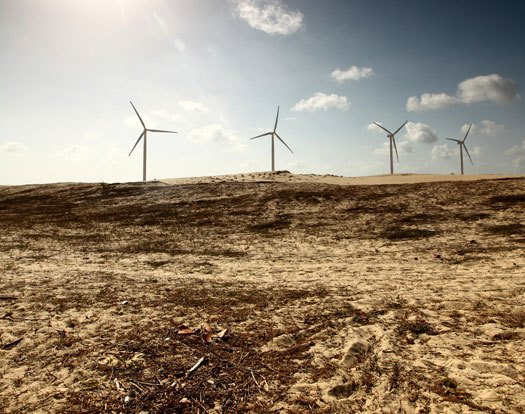 Desert Windmills, with permission from Shutterstock
Desert Windmills, with permission from Shutterstock One of the more remarkable sights on my recent trip was a vast wind farm outside of Palm Springs. Located on the San Gorgonio Mountain Pass in the San Bernadino Mountains, it contains more than 4000 separate wind turbines and provides enough electricity to power Palm Springs and the entire Coachella Valley.
But for critics, large scale wind power used to generate electricity is not inherently clean at all, but only somewhat less dirty than the fossil fuels they are purported to replace. Bruce Pavlik, in a piece for The Los Angeles Times, warned that if we're not careful, a rush to produce green energy could do irrevocable damage to some fragile California ecosystems. "California's desert lands are in some ways a perfect fit with the renewable energy industries necessary to combat climate change," Pavlik writes. "There's sun. There's wind. There's space. But the biologically rich and arid desert ecosystems are remarkably fragile."
Once topsoil and plant life have been disrupted for the placement of solar arrays, wind farms, power plants, transmission lines and CO2 scrubbers, restoration would be cost-prohibitive, if not technically impossible and in any case can take 100 years or more to install. Pavlik cautions that widespread desert construction, even of projects aimed at environmental mitigation, "would devastate the very organisms and ecosystems best able to adjust to a warming world."
As physical equipment, wind farms also use an awful lot of physical resources. The compartments at the top of each tower, that contain the generator, hub and gearbox, each weigh 15,000 kilos upwards (30,000 to 45,000 pounds). Other components of a utility-scale wind farm include underground power transmission systems, control and maintenance facilities and substations that connect farms with the utility power grid. That's a lot of embodied energy.
At the moment, more vast projects are moving ahead. The U.S. Bureau of Land Management is processing more than 180 permit applications from private companies to build solar and wind projects in California deserts. One such venture, the Ivanpah Solar Electric Generating System, scheduled to begin construction in a beautiful valley near the California-Nevada border in San Bernardino County, will occupy 3,400 acres and that doesn't include the land needed for transmission lines. Most projects are even larger, averaging 8,000 acres; some exceed 20,000 acres. According to The Los Angeles Times, the total public land under consideration for alternative energy production exceeds 1.45 million acres in California alone.
"We need to acknowledge the true costs of any energy development," Pavlik concludes. "When a dam is built, a river is lost. But people who turn on their tap and draw that water rarely think about the river that was destroyed to produce it. Similarly, if we choose to place our "ugly" industrial technologies in the wilderness, there will be less awareness of the damage, less incentive to conserve."
This essay was originally published on Doors of Perception, August 2, 2010.

